 © Nevit Dilmen, CC BY-SA 3.0 https://creativecommons.org/licenses/by-sa/3.0, via Wikimedia Commons
© Nevit Dilmen, CC BY-SA 3.0 https://creativecommons.org/licenses/by-sa/3.0, via Wikimedia CommonsAbstract
INTRODUCTION: Ultrasound guidance is now widely available in military treatment facilities and civilian hospitals alike, both in the USA and in forward-deployed military environments. Technical mastery of ultrasound-guided peripheral intravenous (USGPIV) catheter insertion can be easily achieved through a short training course. Mastery can be achieved even when trainees have a limited medical background before course attendance. An evidence-based practice project team sought to improve the knowledge, confidence, and skills in the placement of USGPIV catheters by clinicians at Naval Hospital Jacksonville. Completion of an USGPIV training program can equip healthcare providers with knowledge and confidence for placement of peripheral access necessary in critical situations such as those requiring medications or blood products. MATERIALS AND METHODS: The project team conducted a literature review to evaluate the appropriateness of USGPIV training for the nurses and military medical technicians in this setting. The team developed and delivered a USGPIV training program based on adaptations from the literature. During the training period, knowledge and confidence scores were reported by each trainee to evaluate the perceptions of the quality of training. The number of attempted catheter placements and ultrasound utilization was recorded in the pre- and post-implementation periods to evaluate the project’s effect on the delivery of patient care. Statistical analysis was conducted to evaluate project outcomes. RESULTS: In the pre-intervention period, none of the 252 intravenous catheters were placed with the USGPIV technique, compared to 50 of 267 in the post-intervention period. These results demonstrate an 18.7% increase in the USGPIV access approach by nursing staff. Mean knowledge scores significantly increased following the delivery of the training, 60% versus 80% in the pre- and post-training assessments, respectively (P < .001). Mean self-reported skill confidence scores also significantly improved (P < .001). CONCLUSION: Knowledge and self-reported confidence in USGPIV access improved for the trainees. Mean knowledge improved from 60% to 80%, while mean confidence scores increased from 2.74 to 3.79 for corpsman and from 3.0 to 3.88 for nurses. Utilization of the USGPIV technique increased by 18.7% in the post-intervention period. These results demonstrate that implementing this training program can improve knowledge, confidence, and use of ultrasound during the placement of PIV catheters.